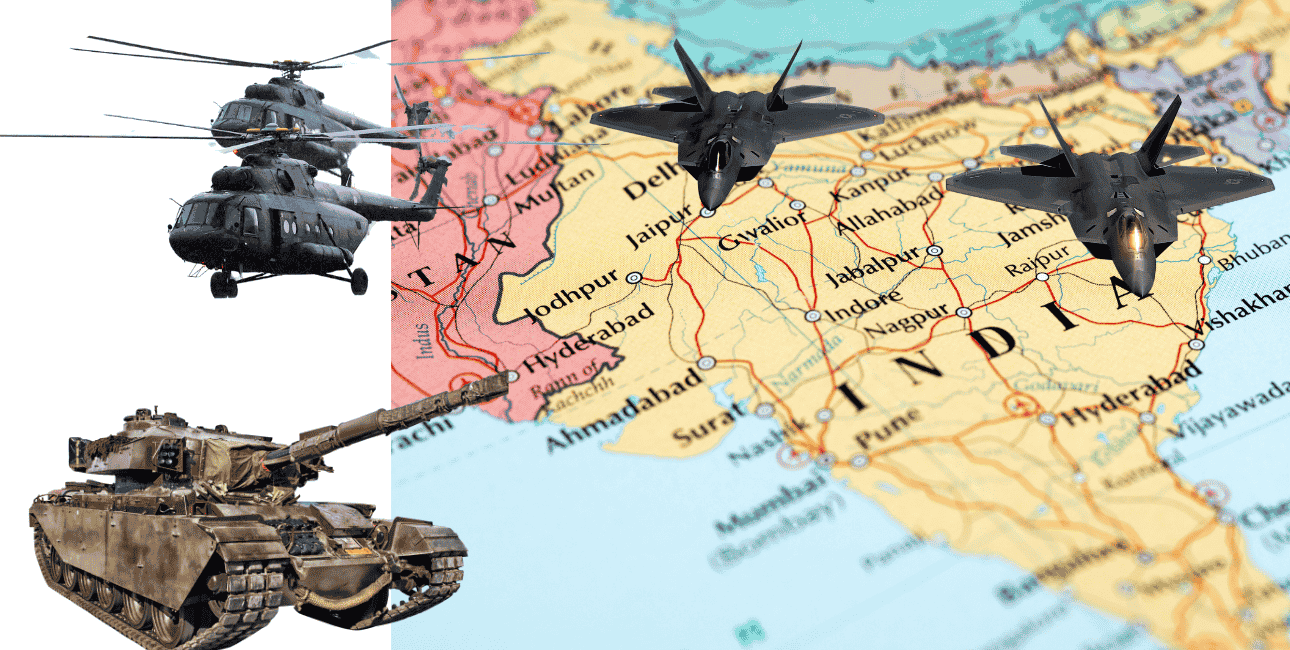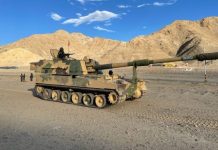By Air Marshal (R) RGK Kapoor (R)
India’s defense production has reached Rs 1.27 lakh crore in FY 2023-24, marking a 174% rise since 2014-15 when the ‘Make in India’ initiative was launched. At the same time, defense exports have also risen to a record high of Rs 21,083 crore, expanding 30 times in one decade.
Presently, Indian defense exports are reaching more than 100 countries. This signifies the resilience of the Indian defense industry and sustained efforts in policy implementation.
India has traditionally been an importer of defense equipment. Even the recent SIPRI report placed India as the number two arms importer, behind Ukraine. This is, however, likely to change as the contribution of the private defense industry increases.
The domestic industry manufactures fighter aircraft, ships, submarines, main battle tanks, unmanned aerial vehicles, helicopters, artillery systems, and missiles. Recent orders for 156 Light Combat Helicopters (LCH), Advanced Towed Artillery Gun System (ATAGS), and NAG missile systems will further consolidate the position and credibility of domestic manufacturers.
The defense budget for FY 2025-26 has earmarked Rs 1,11,544 crores for procurement from domestic industry out of Rs 1,48,722 crores allocated for capital acquisitions. As much as 25% of the domestic industry allocation is earmarked for procurements from private industry, highlighting the government’s commitment to promoting the private defense industry.

This is also likely to provide impetus to the private industry to invest more in R&D, which is currently lacking. A larger share of indigenous products in the Indian armed forces would enhance export avenues.
Growth Of The Indian Defense Industry
The domestic defense industry in India has grown substantially. This is a result of the government’s encouragement to source more from private industry and the entry of bigger industry players like Tatas, L&T, Adani, Reliance, Mahindra, Bharat Forge, and many more into defense manufacturing. Another factor has been their collaborations with foreign OEMs in joint ventures, which have helped the industry absorb technology and manufacturing.
Similarly, the PSUs have expanded their portfolios and are now sourcing more from MSMEs. The establishment of defense corridors in Uttar Pradesh and Tamil Nadu has also helped the cause.
Another factor in this growth has been the offset contracts associated with imports of defense equipment. About US$4.7 billion worth of offset contracts have been signed since 2007. This has provided much-needed impetus to domestic private industry, especially in the aerospace sector.
India imported almost 70% of its defense equipment in the early 2000s, but the incredible turnaround under Make in India has led to 65% of defense equipment being manufactured domestically.
From 16 PSUs that held the monopoly of producing or assembling defense equipment, today, there are more than 430 licensed companies and over 16,000 MSMEs. Indian tech startups (around 194) in this field have also added value through innovation and collaboration with foreign partners in providing efficient, economical, and technologically advanced solutions.
Innovation for Defense Excellence (iDEX) has provided additional impetus, under which Rs 449.62 crore has been allocated for developing innovative technologies. Acing Development of Innovative Technologies with iDEX (ADITI) was launched recently to support critical and strategic technologies such as satellite communication, advanced cyber technology, autonomous weapons, semiconductors, artificial intelligence, quantum technology, nuclear technologies, and underwater surveillance. Under this scheme, grants of up to Rs 25 crore are provided to innovators.
The Self-Reliant Initiatives through Joint Action (SRIJAN) portal was launched to provide definitive guidance on the indigenization of imported items. The website hosted a list of 38,000 such items, of which 14,000 have been successfully indigenised. The major hurdle in this endeavor has been the delays in the certification of locally developed components and spares by MSMEs.
The progress in exports is also encouraging. Defense exports have witnessed excellent growth over the last decade, growing 21 times from Rs 4,213 crore in 2004-2014 to Rs 88,319 crore in the 2014-24 time period.
The portfolio has diversified to include items from Boots to the Brahmos missile system.
Major equipment being exported includes bulletproof jackets, Dornier-228 transport aircraft, Chetak helicopters, the Brahmos missile system, the Akash Missile System, fast interceptor boats, and lightweight torpedoes.
The government has set an export goal of Rs 50,000 crore ($6B) by 2029. This would require diversifying the export portfolio to higher-value items.
Future of Defense Exports
The market for defense exports from India comprises developing countries, including some in West Asia. Recent conflicts are indicators of future wars. Space, Cyber, and Electronic Warfare will play a significant role in operations. AI, autonomy, robotics, and quantum technologies will impact all future operations. The industry needs to focus on these fields to compete with others for exports.
Progress made in drone and counter-drone technologies, radars, electronic warfare equipment, helicopters, weapons, missile systems (air-to-air, surface-to-air, surface-to-surface), and fighters like LCA Mk1, and MkII opens up export opportunities.
ALH has not been a great success story, with more than 330 helicopters grounded for the umpteenth time since January 25. Light Utility Helicopter (LUH) and Light Combat Helicopter (LCH) should not suffer the same fate, and necessary corrective actions should be implemented to succeed in the export market.
India’s biggest advantage of being viewed as a friendly nation must be leveraged, along with the competitive cost of platforms and equipment. Additionally, we could collaborate with like-minded nations within Asia to produce future systems and expand our reach.
Defense equipment is technology-intensive and, hence, sensitive to technological change. The defense industry must, therefore, be able to match the world’s technological evolution. It must also be cost-effective in a highly competitive market.
Growing Chinese exports serve as an example, especially for exploring opportunities in Asia, Africa, and South America. An agency to identify futuristic technologies and guide their development must be established.
Way Forward
India needs to continuously explore and map potential export opportunities. To this end, a cell in the MoD with representation from the three services/ HQ IDS, and MEA should be created to work with the defense industry in identifying export opportunities.
Scan current technologies and those of the future. If the Advanced Medium Combat Aircraft (AMCA) is produced by 2035, it will be the last fifth-generation fighter in the world.
By then, countries would have captured the market ahead of India. Similarly, the export opportunities for LCA Mk2 and its export configuration should be finalized during the development process.
Shortlist successful ventures and products like ground-based radars, airborne radars, air-to-air missiles like ASTRA, air-to-ground weapons like SAAW, and range extension kits for air-to-ground bombs for export. The private defense industry is producing a wide variety of UAVs, including loitering munitions, which could also be leveraged for export.
India should target developing countries, and where required, exports could be facilitated by extending a line of credit specifically for defense equipment. There have been both successes and failures in this area. These need to be reviewed and refined to enhance the success rate.
Establish a help desk to assist startups and MSMEs in connecting with defense majors and OEMs abroad, enhancing their visibility and reach in foreign markets. This could be showcased through the Indian embassies in selected countries.
Review approval processes for export and make them flexible, easy, and efficient to ensure ease of export.
Integration of imported components like engines and electronics is a potential showstopper for export due to diplomatic issues or export clearances for these items. The products would be more acceptable if they were completely indigenous with minimal import content, especially of critical components.
Ukraine has pioneered innovations in drones during the ongoing war with Russia. These innovations could be leveraged to kick-start an entirely new drone ecosystem in India with expertise from Ukraine’s industries. Acquisitions or collaborations are two options.
Conclusion
Indian defense industry has witnessed remarkable growth in the last decade. From being an import-dependent country, the landscape has reversed, with 65% domestic production. India is now exporting contemporary defense equipment to more than 100 countries, including the USA and France.
With modern equipment like fighter aircraft, helicopters, main battle tanks, artillery systems, surface-to-air missiles, aircraft carriers, and other ships being manufactured in India, it is now time to achieve parity with nations currently exporting major defense equipment.
Leverage cost and engineering talent advantage (a large number of global capability centers are located in India). Compress the time from development to production to be competitive in a time-sensitive market.
A focused approach is needed to capture the defense market for Indian products like fighter aircraft, helicopters, ships, weapons, and land systems. Increasing presence and outreach would pay rich dividends in this regard.
It is imperative that our technology development and deployment are executed in a time-bound manner to send the right signal to potential buyers. A proactive approach is hence the need of the hour to achieve export targets.
- Air Marshal (R) RGK Kapoor, PVSM, AVSM, VM, is a retired officer of the Indian Air Force. He served as the Air Officer Commanding-in-Chief (AOC-in-C) of Central Air Command.
- Mail EurAsian Times at editor (at) eurasiantimes.com




